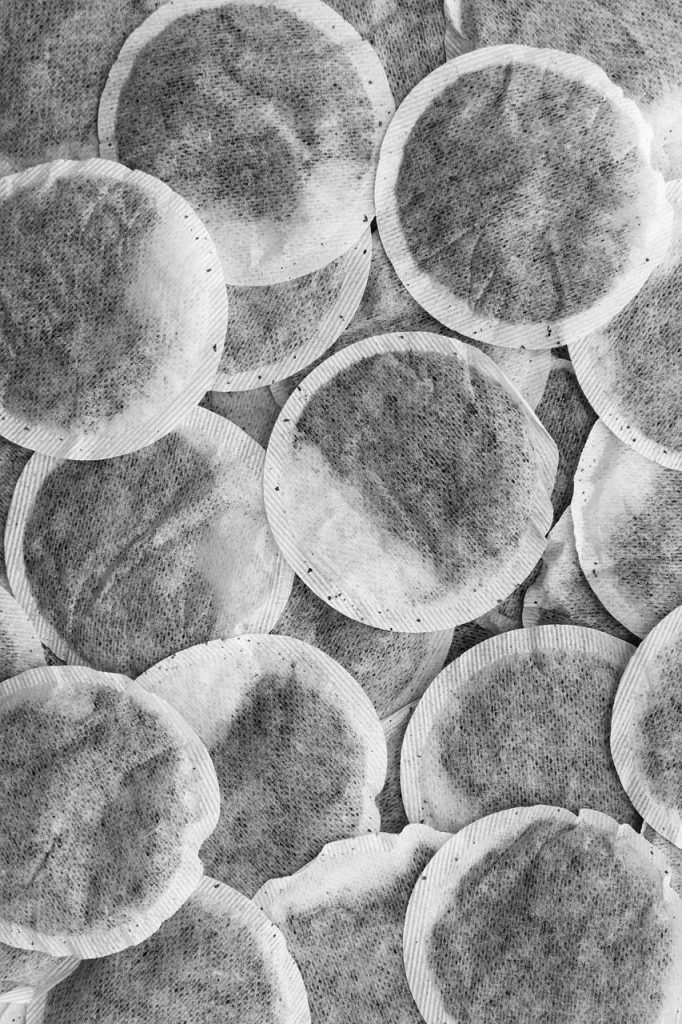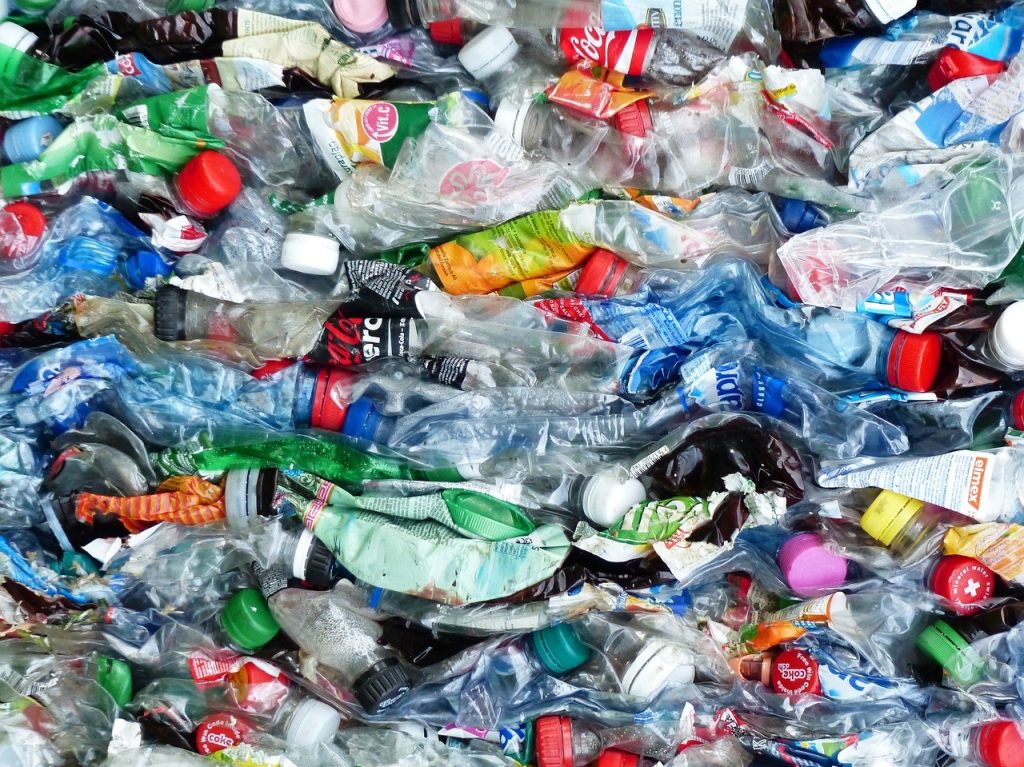Prefer podcasting? Check out Episode 3: Steeped in Plastic of The Hideaway Tea Pod.
One Serving of Microplastics Coming Right Up
A widely known study in 2019 by McGill University revealed that…
“…a single plastic teabag at brewing temperature (95 °C) releases approximately 11.6 billion microplastics and 3.1 billion nanoplastic particles into a single cup of the beverage.” [1]
Anything at scalding temperatures evidently breaks down plastic, and yet it’s almost laughable (in the anxious kind of way) to relearn that we’re drowning in plastic and sometimes don’t even know it. This research shook the world of tea and continues to be a major topic of discussion in the food industry – how much plastic are we unknowingly consuming and how does this affect us? Today, we’re exploring plastic’s broader impact on tea, our food, and the world.
A Glimpse Across Time
Before unfolding the modern-day issue that is our plastic excess, for a bit more context, let’s briefly peer into how plastic originally came to be.
One important figure in plastic’s history is John Wesley Hyatt, who invented the first synthetic polymer in 1869 by treating a naturally existing polymer cellulose (derived from cotton fiber) with camphor. During his time, Hyatt addressed the world’s ivory shortage and extinction-approaching elephant population by inventing a craftable and inexpensive substitute material named celluloid. Likewise, in 1907 Leo Baekeland invented Bakelite, the first fully synthetic (no molecules found in nature) plastic by chemically combining phenol and formaldehyde to substitute ivory and shellac. Ironically, plastic at the time was deemed as “the savior of the elephant and the tortoise” [2].
The irony continues – today, plastic products meant for single-use are manufactured to last for centuries. Because plastic does not biodegrade or readily decompose, we find ourselves literally swimming in the stuff at a molecular scale. However, it would be unfair to dismiss plastic’s continuous contribution to modern-day society – this easily producible, cheap, moldable, durable, and lightweight material allows us to preserve, transport, and distribute food around the globe, create fabrics and clothes, construct cars, buildings, and electronics economically, and more. While it would be easiest to either immediately antagonize and boycott plastic or to utterly and unrightfully ignore plastic’s ongoing damage, the reality is that plastic has brought humanity to where it is today and will continue to walk alongside us for the foreseeable future. Let’s continue to examine plastic under a microscope to further our understanding of its role in the food industry.
Plastic in Food Production
There are a number of plastic types which we most commonly use around our food. Excluding plastic #7 (the miscellaneous category), these plastics are all derived from crude oil or natural gas and have been deemed by the FDA as ‘food-grade’, meaning they do not leach harmful chemicals into food and can physically withstand the intended temperatures, pressures, and acids that they are exposed to. They include [3]:
Admittedly, the amount of conflicting information regarding the safety of these materials in relation to food is overwhelming. Some sources state that all food-grade plastics are safe within their intended environments or that their microplastic leachates fall far below dangerous volumes. Other sources state that PVC {3} and PS {6} should be avoided completely as they can easily leach into foods. Particularly because researchers are constantly learning more, the average consumer becomes paralyzed, never knowing enough. What plastic number do we use for which food at what temperature at all times?
We assume that manufacturers have figured all this out for us before we’ve purchased their products, yet it is incontrovertible that microplastics of some amount leach into our foods even in their intended environments, as the 2019 McGill study proves. What does today’s research have to say about how this impacts our health?

Microplastics Under a Microscope
The McGill study of 2019 continued to discover the toxicity of the extracted liquid of tea bags (composed of PET and nylon) and revealed that leachate exposure caused anatomical and behavioral abnormalities in Daphnia magna, small planktonic crustaceans.
Further studies have revealed that polystyrene exposure in mice leads to impairment of learning and memory abilities while polyethylene exposure in mice induces inflammation and an imbalance in the distribution of gut microbiota [4][5].
Over recent years, the results of several other cellular and animal experiments reveal to us that microplastics can affect various systems in the human body, including the digestive, respiratory, and immune systems. Microplastics can cause inflammation, oxidative damage, and DNA damage, known risks for cancer development [6]. We also understand that microplastics, particularly chemicals bisphenol A (BPA), phthalates, flame retardants, and per- and polyfluoroalkyl substances (PFAS, the ‘forever chemicals’) in plastic, can cause endocrine disruption which interferes with the body’s natural hormonal system and can further impact development, reproduction, metabolic, and neurological function [7]. To date, researchers are still learning more about how microplastics interact with our bodies and what their long-term risks are.

What’s most concerning is scientists’ detection of microplastics in human livers, kidneys, testicles, breast milk, blood, and brains. This is inevitable as microplastics have become small enough to permeate through our cells, farmlands, food chain, water filtration systems, and atmosphere. One study calculated that the average American eats, drinks, and breathes roughly 78,000-211,000 microplastic particles a year (and this is considered to be a drastic underestimate) [8].
Yikes.
The Future of Plastic
As terrifying as this all may be, I don’t want to leave you panicking. The issue of microplastics is undoubtedly a global threat, however the first step to any problem is awareness. Currently, scientists and researchers are developing innovative methods to address this issue:
- German company Wasser 3.0 gGmbH developed a system of detecting microplastic pollution with fluorescent markers and bulk-removing microplastics from water by clumping them with a non-toxic hybrid silica gel [9]
- Scientists of Sichuan University developed a proof-of-concept solution, a miniature robot fish which can adsorb and remove microplastics from water environments [10]
- French biochemistry company Carbios implemented bio-recycling by genetically engineering plastic-eating enzymes (found in bacteria and fungi) to depolymerize PET and remanufacture bottle-grade PET [11]
Additionally, many brands (including tea brands) are making changes to become plastic-free by utilizing biodegradable plant-based materials including abaca, polylactic acid (PLA), cellulose, and cotton in product packaging. Bioplastics aren’t necessarily a sweeping solution to our plastic crisis as they require significantly more land and resources for production, however they certainly point us in the right direction.
Final Reflections
It’s difficult to fathom how all of this might be fixed one day or what any of us can do regarding this global situation, and it’s tempting to sink into despair. However, rest assured that changes are being made (albeit gradually) and that there is hope. While we get through this wild world together, some of the actions that we can take to preserve ourselves as well as our environment include:
- Consuming mindfully – When we choose to purchase products with plant-based, biodegradable, or zero packaging, we are decreasing the demand, distribution, and potential contamination of plastic in the world. We can also prevent chronic health risks and protect our own bodies by avoiding single-use plastics like water bottles, tea bags, and Styrofoam™ cups.
- Cleansing – There currently isn’t any existing technology with which we can remove microplastics from our bodies. However, in combination with reducing exposure, some proposed ‘detoxing’ solutions include increasing fiber intake, exercising (to induce sweating), or donating blood.
- Getting creative – Why not try sowing your own reusable napkins? Or, instead of ordering takeout, cook a wholesome meal? Or make your own soap! There are plenty of small, creative, and even fun ways through which you can reduce your consumption of plastic packaging.
Although the happy ending of our plastic crisis seems quite far away, I want to encourage you to simply acknowledge the reality of our current state and to keep moving forward. Don’t allow worry to overtake you or disrupt your day-to-day, as if worrying can add a single day to your life or clean up our massive mess. Let’s each take action in our own personalized way, however best we can, and make the most of what we have.
References
- Hernandez, L. M., Xu, E. G., Larsson, H. C. E., Tahara, R., Maisuria, V. B., & Tufenkji, N. (2019). Plastic Teabags Release Billions of Microparticles and Nanoparticles into Tea. Environmental Science & Technology, 53(21), 12300–12310. https://doi.org/10.1021/acs.est.9b02540
- Science History Institute. (2024, January 3). History and Future of Plastics | Science History Institute. https://www.sciencehistory.org/education/classroom-activities/role-playing-games/case-of-plastics/history-and-future-of-plastics/
- Plastic by the numbers. (2023, October 18). https://plasticactioncentre.ca/directory/plastic-by-the-numbers/
- Li, B., Ding, Y., Cheng, X., Sheng, D., Xu, Z., Rong, Q., Wu, Y., Zhao, H., Ji, X., & Zhang, Y. (2019). Polyethylene microplastics affect the distribution of gut microbiota and inflammation development in mice. Chemosphere, 244, 125492. https://doi.org/10.1016/j.chemosphere.2019.125492
- Wang, S., Han, Q., Wei, Z., Wang, Y., Xie, J., & Chen, M. (2022). Polystyrene microplastics affect learning and memory in mice by inducing oxidative stress and decreasing the level of acetylcholine. Food and Chemical Toxicology, 162, 112904. https://doi.org/10.1016/j.fct.2022.112904
- Goswami, S., Adhikary, S., Bhattacharya, S., Agarwal, R., Ganguly, A., Nanda, S., & Rajak, P. (2024). The alarming link between environmental microplastics and health hazards with special emphasis on cancer. Life Sciences, 355, 122937. https://doi.org/10.1016/j.lfs.2024.122937
- Lee, Y., Cho, J., Sohn, J., & Kim, C. (2023). Health effects of microplastic exposures: current issues and perspectives in South Korea. Yonsei Medical Journal, 64(5), 301. https://doi.org/10.3349/ymj.2023.0048
- Cox, K. D., Covernton, G. A., Davies, H. L., Dower, J. F., Juanes, F., & Dudas, S. E. (2019). Human consumption of microplastics. Environmental Science & Technology, 53(12), 7068–7074. https://doi.org/10.1021/acs.est.9b01517
- UpLink. (n.d.). https://uplink.weforum.org/uplink/s/uplink-contribution/a012o00001pTYKFAA4/wasser-30-detect-remove-reuse
- Quaglia, S. (2022, June 22). Scientists unveil bionic robo-fish to remove microplastics from seas. The Guardian. https://www.theguardian.com/environment/2022/jun/22/scientists-unveil-bionic-robo-fish-to-remove-microplastics-from-seas
- Johnson, B. (2024). Plastic-eating bacteria boost growing business of bioremediation. Nature Biotechnology. https://doi.org/10.1038/s41587-024-02401-1



